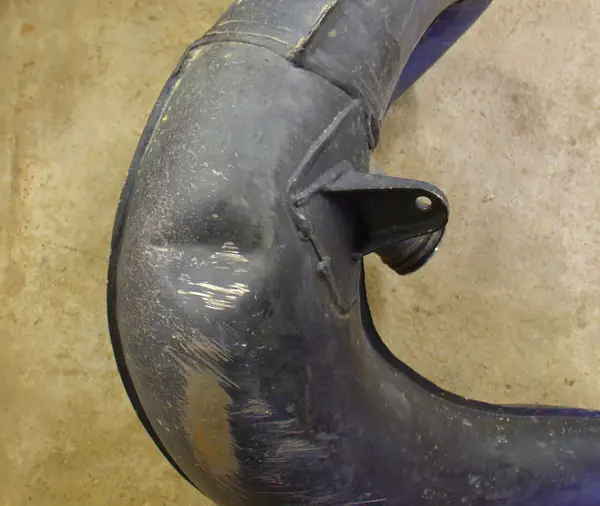THIS MUCH WE KNOW: THE TRUTH ABOUT SPEED DENTS, ROCK DINGS AND PIPE CATASTROPHIES

Have you ever dented a brand-new two-stroke pipe? Sure you have. It’s a part of life. The question is, how much horsepower will you lose when you put a big divot in your pipe? To find out, we took a KTM 125X, strapped it to a dyno and started making runs. Our intent was to discover what effect dents have on exhaust pipes. Here is what we found out.
THE SMALL-DENT EXPERIMENT
After making a few baseline runs on our KTM 125SX, we mounted a brand-new Pro Circuit exhaust pipe. Voila! It gained 1-1/2 horsepower at peak. Then we dented it (exactly 10 inches from the exhaust manifold). To make the dent, we hit the first cone with a ball-peen hammer. We hit it hard, producing a 2-inch-wide, 1/2-inch-deep depression.
Small-dent results: Surprise! We gained an average of 1/10th of a horsepower from the bottom end up to 12,000 rpm. Believe it or not, the small dent produced slightly more power through the range and made 1/5th of a horsepower more at peak. After peak horsepower, there was a loss of power compared to our undented run.
THE LARGE-DENT EXPERIMENT
Shocked by the result of our first test, we applied more force (with a much larger hammer). Our small dent suddenly became a much larger dent. The new dent was 3 inches in diameter and 3/4 of an inch deep.
Large-dent results: Holy smokes! With the large dent, the peak power was 1/5th of a horsepower more, but more shocking, the powerband was broader at max. On the downside, over-rev dropped off just like with the small dent when compared to the test’s baseline pipe.
HEAD-PIPE-DENT EXPERIMENT
In the first two tests, we had simulated your average crash damage. In test three, we were looking for a head-pipe ding (approximately 6 inches away from the exhaust flange instead of 10 inches). Our dent was a small, 1-inch-diameter dent with a 1/2-inch depth. This kind of dent comes from rocks, ramming downed bikes or casing jumps.
Head-pipe-dent results: Disaster! At 6000 rpm, we were down half a horse. At 8000 rpm, the two pipes were equal. At 11,000 rpm, the dented head pipe was down a half horse again. At peak power, it was down a full horsepower. It’s obvious that a dent in the head pipe is a problem.
CENTER-CONE-DENT EXPERIMENT
Just for kicks, we slammed the side of the pipe (at its largest diameter) with a sledgehammer. This kind of dent is very rare, but can happen in a fall-over- or run-over-style accident. To make it more interesting, we left the head-pipe dent and first cone dents in the pipe to see if the center-cone dent could add to the misery.
Center-cone-dent results: There was no difference in horsepower output with a center-cone dent.

WHAT DOES IT ALL MEAN?
There are three conclusions to be drawn from MXA’s speed-dent test:
(1) The worst dent is one located in the first 6 inches of the exhaust pipe. A dent in the head pipe will hurt both the bottom and the top (and the fall-off before peak will be significant). If your exhaust pipe gets a dent in the head pipe?or even worse, is squashed flat?it needs to be replaced.
(2) The typical rock dent in the pipe’s first cone (approximately 10 inches away from the exhaust flange) is nothing to worry about. Although it can cost some over-rev on top, it does not hurt horsepower at or below peak (quite the contrary).
(3) Center-cone dents are not a big deal.
WHERE TO GET IT FIXED
If you do dent your pipe, you can send it to Pacific Coast Pipe Repair (www.piperepair.com) at (541) 664-0400 or Fusion One (www.fusiononeusa.com) at (860) 992-4377. The base price for most repairs is $60.00





Comments are closed.